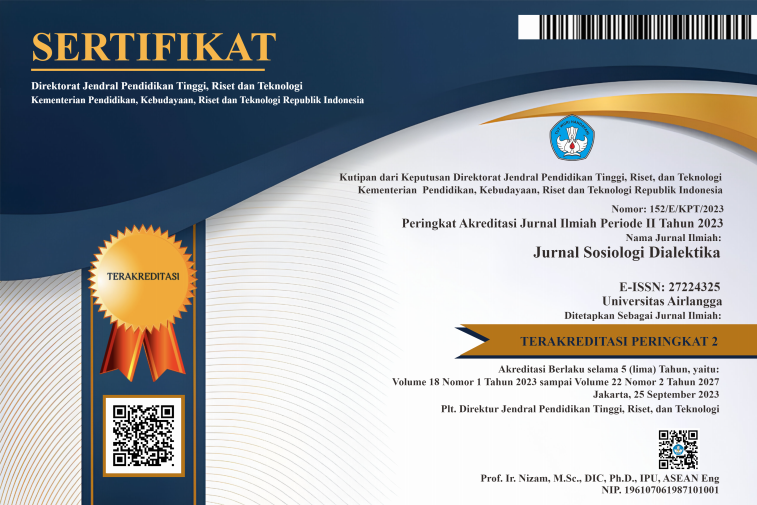Feminization of poverty program on female breadwinners in East Java, Indonesia
Downloads
This article describes the feminization of poverty-reducing program by directing the program to female breadwinners in 10 regencies in East Java Province, Indonesia. The main activity of such program is to provide productive financial support to a target group, namely poor female breadwinners in rural areas. The main focus of the research is to examine the targeting accuracy of the program in providing productive financial support to the target group. To acquire this objective, a survey was conducted to collect data for the examination. In addition, the targeting accuracy is measured for the accuracy of its recipients, its amount, and its utilization. The results of the study indicate that the feminization of poverty-reducing program has met the target. It means that the funds have really been given to the poor female breadwinners who live in rural areas. The sum of the money has been in agreement with the amount that should be given, and it has been utilized by the target group productively in accordance with the program objectives.
Ariyani N, Fauzi A, Juanda B & Beik IS (2015) Evaluasi pogram pengentasan kemiskinan menggunakan metode rappoverty. Jurnal Ekonomi & Kebijakan Publik 6 (2):181-197.
Ashiomanedu J (2008) Poverty and sustainable development in the Niger delta region of Nigeria. Journal of Sustainable Development in Africa 10 (3):155-171.
Bastos A, Casaca SF, Nunes F & Pereirinha J (2009) Women and poverty: A gender sensitive approach. The Journal of Socio-Economics 38 (5):764-778.
Brady D & Kall D (2007) Nearly universal, but somewhat distinct: The feminization of poverty in affluent western democracies, 1969-2000. Social Science Research 37 (3):976-1007.
Cobbinah PB, Black R & Thwaites R (2013) Dynamics of poverty in developing countries: Review of poverty reduction approaches. Journal of Sustainable Development 6 (9):25-35.
Domfeh KA & Bawole JN (2009) Localizing and sustaining poverty reduction: Experiences from Ghana. International Journal of Management of Environmental Quality 20 (5):490-505.
Fosu AK (2017) Growth, inequality, and poverty reduction in developing countries: Recent global evidence. Research in Economics 71 (2):306-336.
Goswami R & Majundar S (2016) Construction of gender sensitive poverty line based on local perception: Evidence from Habra-II Block of West Bengal state in India. The Social Science Journal 54 (1):76-92.
Husna DN (2018) Efektifitas program Jalin Matra terhadap kesejahteraan janda miskin di Desa Sumberjo Kecamatan Sanankulon Kabupaten Blitar ditinjau dari ekonomi Islam. Martabat: Jurnal Perempuan dan Anak 2 (2):202-2018.
Jackson C (1998) Woman and poverty or gender and well-being? Journal of International Affairs 52 (1):67-81.
Klasen S, Lechtenfeld T & Povel F (2013) A feminization of vulnerability? Female headship, poverty, and vulnerability in Thailand and Vietnam. World Development 71:36-53.
Kurniawan YT (2018) Strategi optimalisasi program penanggulanagan kerentanan kemiskinan (Studi kasus program Jalin Matra PK2 di Desa Ngroto Kecamatan Pujon Kabupaten Malang. Cakrawala 12 (1):95-105.
Mahsunah D (2013) Analisis pengaruh jumlah penduduk, pendidikan dan pengangguran terhadap kemiskinan di Jawa Timur. Jurnal Pendidikan Ekonomi 1 (3):1-17.
Mederios M & Costa J (2008) Is there a feminization of poverty in Latin America? World Development 36 (1):115–127.
Mufidah S (2018) Implementasi Program Jalan Lain Menuju Mandiri dan Sejahtera (Jalin Matra) dalam Penanggulangan Kerentanan Kemiskinan (PK2) di Desa Domas Kecamatan Menganti Kabupaten Gresik. Theses: Universitas Airlangga Surabaya.
Nurmawati Y & Soseco T (2017) The effectiveness of Jalin Matra Penangulanan Kerentanan Kemiskinan Programme in Village of Ngroto. Jurnal Ekonomi dan Studi Pembangunan 9 (2):167-175.
Pearce D (1978) The feminization of poverty: Woman work and welfare. Urban and Social Review 11:28-36.
Perdana AA & Maxwell J (2004) Poverty Targeting in Indonesia: Programs, Problems and Lessons Learned. Dalam: Centre for Strategic and International Studies Economic Working Paper Series, Jakarta, Indonesia.
Pressman S (2003) Feminist explanations for the feminization of poverty. Journal of Economic Issues 36 (2):353-361.
Singgih DS & Sudarso (2013) Evaluasi Pelaksanaan Program Jalin Kesra Bantuan RTSM Provinsi Jawa Timur. Surabaya: Kerjasama antara Badan Pemberdayaan Masyarakat Provinsi Jawa Timur dengan Lembaga Penelitian dan Pengabdian pada Masyarakat Universitas Airlangga.
Singgih DS, Sudarso & Mas'udah S (2020) The use of mixed methods to identify typology of poverty in East Java, Indonesia. Jurnal Sosiologi Dialektika 15 (1):9-15.
Tain A (2011) Penyebab kemiskinan rumah tangga nelayan di wilayah tangkap lebih Jawa Timur. Humanity 7 (1):1-10.
Tarkowska E (2002) Intra-household gender inequality: Hidden dimensions of poverty among Polish women. Communist and Post-Communist Studies 35 (4):411–432.
Zamhari J, Wisadirana D & Kanto S (2015) Analisis determinan kemiskinan di Jawa Timur. Wacana 18 (1):41-50.
Zarkasi (2015) Pedoman Umum Pilot Project Jalin Matra Penanggulangan Kerentanan Kemiskinan. Surabaya: Badan Pemberdayaan Masyarakat.
1. Copyright of this journal is possession of Editorial Board and Journal Manager, by the knowledge of author, whilst the moral right of the publication belongs to the author.
2. Legal formal aspect of journal publication accessibility refers to Creative Commons Attribution-NonCommercial-ShareAlike (CC BY-NC-SA), implies that publication can be used for non-commercial purposes in its original form (cannot be modified).
3. Every publications (printed/electronic) are open access for educational purposes, research, and library. Other that the aims mentioned above, editorial board is not responsible for copyright violation.















